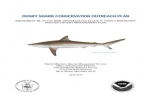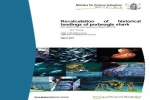Tracking the habitat use of whale sharks off the Pacific coast of Mexico
Published on 4. May 2017 Oceanic adults, coastal juveniles: tracking the habitat use of whale sharks off the Pacific coast of Mexico Dení Ramírez-Macías, Nuno Queiroz, Simon J. Pierce, Nicolas E. Humphries, David W. Sims, Juerg M. Brunnschweiler ABSTRACT: Eight whale sharks tagged with pop-up satellite archival tags off the Gulf of California, Mexico, were
Skeletal Indicators of Shark Feeding on Human Remains
Published on 02. May 2017 Skeletal Indicators of Shark Feeding on Human Remains: Evidence from Florida Forensic Anthropology Cases Michala K. Stock M.A., Allysha P. Winburn M.A., George H. Burgess M. ABSTRACT: This research examines a series of six Florida forensic anthropology cases that exhibit taphonomic evidence of marine deposition and shark-feeding activities. In each
Mercury, arsenic, cadmium and lead in two commercial shark species in Trinidad and Tobago
Published online on 21. April 2017 Mercury, arsenic, cadmium and lead in two commercial shark species (Sphyrna lewini and Caraharinus porosus) in Trinidad and Tobago Azad Mohammed, Terry Mohammed ABSTRACT: Sharks are long-lived apex predators which can accumulate toxic metals such as mercury and arsenic. Samples of Sphyrna lewini and Carcharinus porosus were collected from
X-ray computed tomography library of shark anatomy and lower jaw surface models
Published online on 11. April 2017 X-ray computed tomography library of shark anatomy and lower jaw surface models Pepijn Kamminga, Paul W. De Bruin, Jacob Geleijns, Martin D. Brazeau ABSTRACT: The cranial diversity of sharks reflects disparate biomechanical adaptations to feeding. In order to be able to investigate and better understand the ecomorphology of extant
Clinical features of 27 shark attack cases on La Réunion Island
Clinical features of 27 shark attack cases on La Réunion Island Ballas, Richard MD; Saetta, Ghislain; Peuchot, Charline; Elkienbaum, Philippe MD; Poinsot, Emmanuelle MD ABSTRACT: BACKGROUND: Between January 2000 and September 2016, there have been 27 documented shark attacks on La Réunion Island. The insular nature of La Réunion has allowed us to
Dusky Shark Conservation Outreach Plan
DUSKY SHARK CONSERVATION OUTREACH PLAN AMENDMENT 5B TO THE 2006 CONSOLIDATED ATLANTIC HIGHLY MIGRATORY SPECIES FISHERY MANAGEMENT PLAN APRIL 2017 PDF-DOWNLOAD
Multidisciplinary framework for assessing connectivity of hammerhead sharks across jurisdictional boundaries
Published on 21. April 2017 Crossing lines: a multidisciplinary framework for assessing connectivity of hammerhead sharks across jurisdictional boundaries A. Chin, C. A. Simpfendorfer, W. T. White, G. J. Johnson, R. B. McAuley, M. R. Heupel ABSTRACT: Conservation and management of migratory species can be complex and challenging. International agreements such as the Convention on
Diet and condition of mesopredators on coral reefs in relation to shark abundance
Published on 19. April 2017 Diet and condition of mesopredators on coral reefs in relation to shark abundance Shanta C. Barley, Mark G. Meekan, Jessica J. Meeuwig ABSTRACT: Reef sharks may influence the foraging behaviour of mesopredatory teleosts on coral reefs via both risk effects and competitive exclusion. We used a “natural experiment” to test
Genetic structure and signatures of selection in grey reef sharks
Published on 19. April 2017 Genetic structure and signatures of selection in grey reef sharks (Carcharhinus amblyrhynchos) P Momigliano, R Harcourt, W D Robbins, V Jaiteh, G N Mahardika, A Sembiring, A Stow ABSTRACT: With overfishing reducing the abundance of marine predators in multiple marine ecosystems, knowledge of genetic structure and local adaptation may provide
Spatial overlap of shark nursery areas and the salmon farming industry
Published online on 18. April 2017 Spatial overlap of shark nursery areas and the salmon farming industry influences the trophic ecology of Squalus acanthias on the southern coast of Chile Juan Diego Gaitán-Espitia, Daniela Gómez, Alistair J. Hobday, Ross Daley, Julio Lamilla, Leyla Cárdenas ABSTRACT: Potential interactions between marine predators and humans arise in the
Historical porbeagle shark landings in New Zealand
Recalculation of historical landings of porbeagle shark New Zealand Fisheries Assessment Report 2017/12 Francis, M.P. March 2017 PDF-DOWNLOAD
A Brief Look at Human Impacts on Sharks
Published on 05. April 2017 A Brief Look at Human Impacts on Sharks Strickland J. ABSTRACT: This brief review examines the many human activities that threaten sharks, their impacts, and the implications for the ecosystems that rely upon these apex predators. As keystone species, sharks play a crucial role in maintaining healthy ecosystems by asserting
No persistent behavioural effects of SCUBA diving on reef sharks
Published on 13. March 2017 No persistent behavioural effects of SCUBA diving on reef sharks Darcy Bradley, Yannis P. Papastamatiou, Jennifer E. Caselle ABSTRACT: Despite rapid growth in the marine tourism sector, the impacts of recreation on the marine environment are generally not well understood. Most existing studies of marine recreation ecology have focused on
Molecular basis of ancestral vertebrate electroreception
Published online on 06. March 2017 Molecular basis of ancestral vertebrate electroreception Nicholas W. Bellono, Duncan B. Leitch, David Julius ABSTRACT: Elasmobranch fishes, including sharks, rays, and skates, use specialized electrosensory organs called ampullae of Lorenzini to detect extremely small changes in environmental electric fields. Electrosensory cells within these ampullae can discriminate and respond to
Preliminary recovery of coastal sharks in the south-east United States
Published online on 10. February 2017 Preliminary recovery of coastal sharks in the south-east United States Cassidy D Peterson, Carolyn N Belcher, Dana M Bethea, William B Driggers III, Bryan S Frazier, Robert J Latour ABSTRACT: Relative abundance of many shark species in the Atlantic is assessed by compiling data from several independently conducted, but





